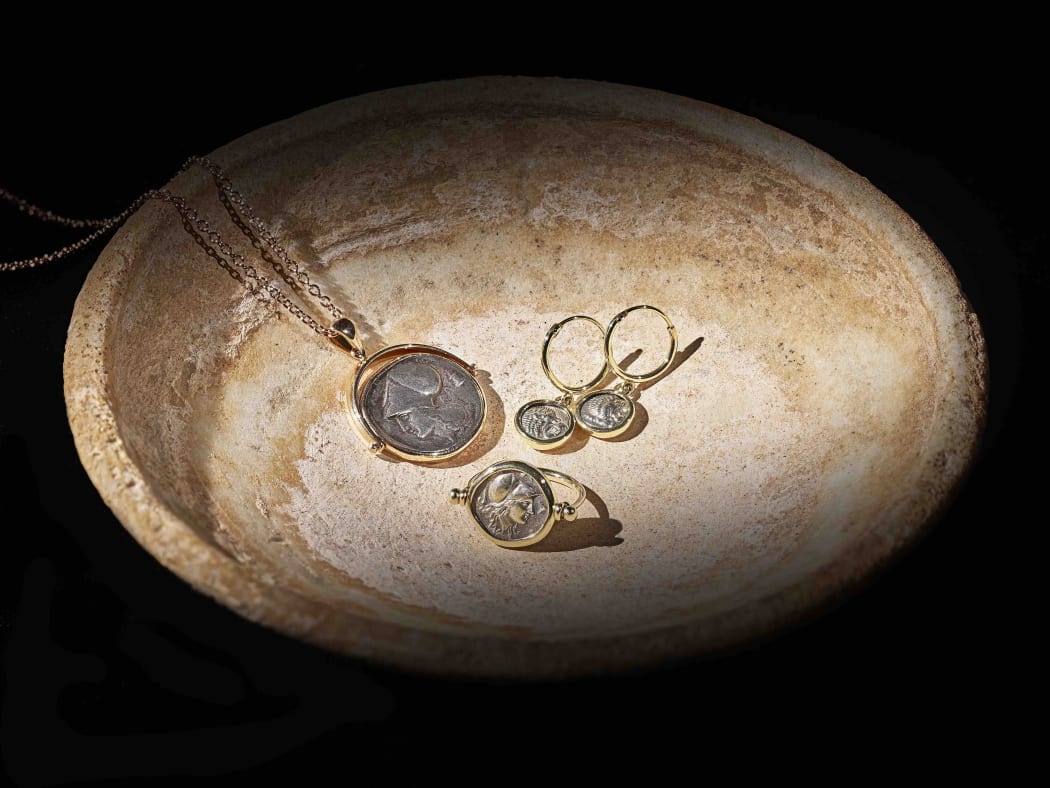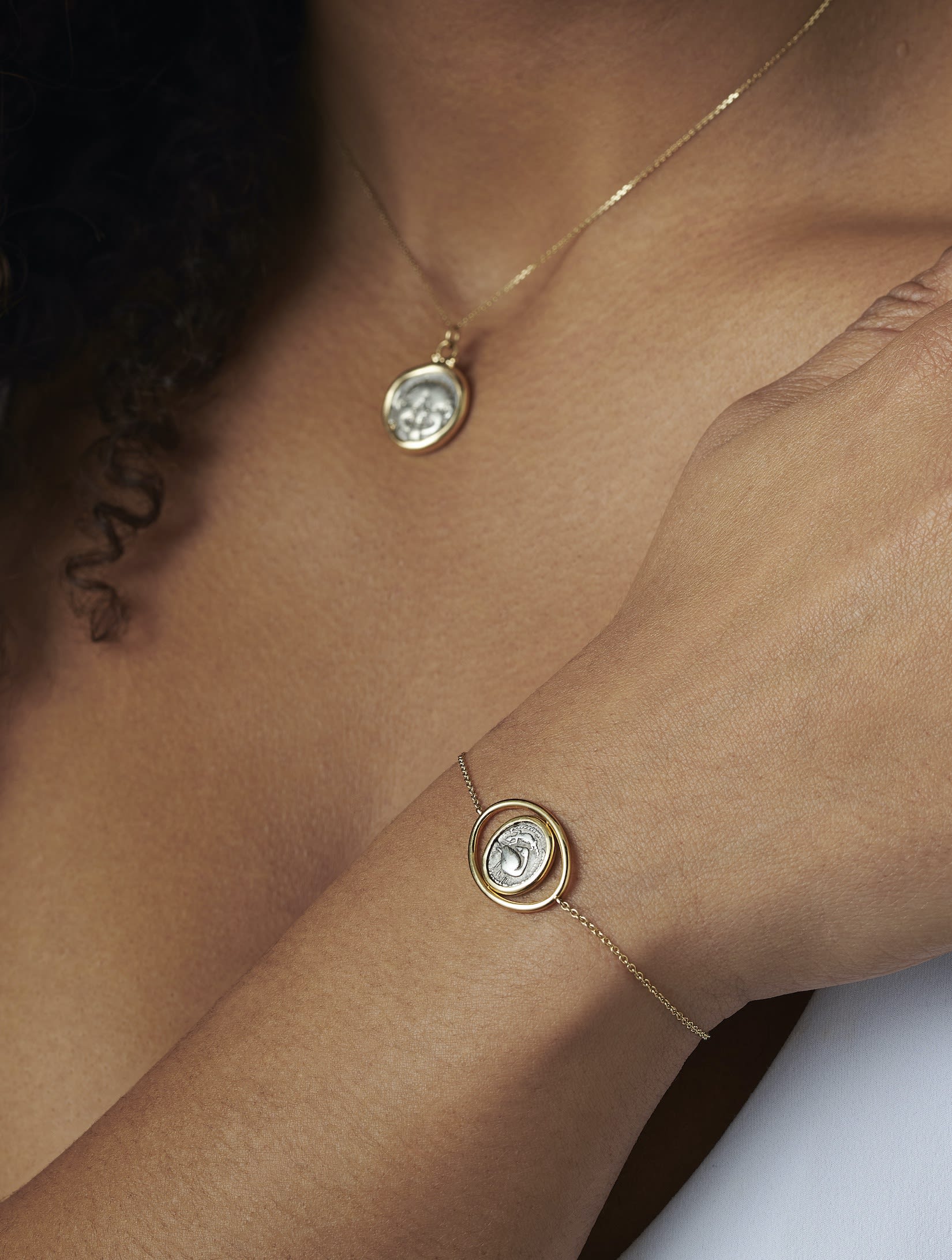
Despite their diminutive size, ancient Greek coins are important monuments of Greek art. These coins are characterised by the brilliant artistry and impeccable skill of the engravers who mastered this art form.
The earliest coins were struck in electrum, a natural alloy of gold and silver, in Lydia around the mid 7th century BC. From this point each city state in Greece minted and produced their own coinage, displaying their own motifs, myths and symbols to emphasise the independence and individuality of the city that minted them.
The designs on ancient coins reveal a great deal about local myths and customs, and provide a glimpse into the different city states, landscapes, and histories that are often not attested anywhere else.
Coins reflect the culture that produced them, including aspects of politics, religion, economics and even fashion. It is even more of a wonder that such exceptional detail can be communicated on such a small scale.
AKARNANIA ROSE GOLD SWIVEL PENDANT

An ancient silver stater of Akarnania, Leukas (circa 320-280 BC) and set in an 18 carat rose gold pendant.
The coin depicts the head of the goddess Athena wearing a Corinthian helmet, with a winged Pegasus flying left on the reverse.
In Greek myth the winged and immortal stallion Pegasus was born from the beheaded gorgon Medusa after she was slain by the hero Perseus. It was the goddess Athena who was said to have tamed and bridled Pegasus. One of the largest constellations of stars is named after the winged horse.
MYSIA GOLD SWIVEL RING

An ancient silver tetrobol of Mysia, Lampsakos (circa 4th - 3rd century BC), set in an 18 carat gold swivel ring.
The coin depicts on one side janiform female heads, each wearing a stephanos with a central earring. The reverse shows the helmeted head of the goddess Athena.
Mysia was a semi-legendary kingdom of ancient Greece, which was located in the north-west corner of Anatolia. Mysia had a rich history and was first mentioned in the epic poetry of Homer. According to myth, the Greeks first landed at Mysia, mistaking it for Troy. It was there that Achilles wounded their king, Telephus.
EION GOLD BRACELET

An ancient silver hemihekte of Eion (circa 450-400 BC), set in an 18 carat gold bracelet.
This delicate coin depicts an animated goose with its head turned back to the right and a lizard hovering above, with a quadripartite incuse square shown on the reverse.
Eion was an ancient Greek colony in Thracian Macedonia, located at the mouth of the river Strymon. The colony was a place of vital strategic importance during the Persian invasions of Darius I and Xerxes I, and later to the Athenians during the Peloponnesian War.
The significance of the goose depicted on the coin presumably refers to scenes from rural life at the time. Being located by a river, die cutters took inspiration from the aquatic birds that would have frequented the shores and marshlands of the area.
MILETOS LION HOOP EARRINGS

A pair of 18 carat gold hoops each set with an ancient silver diobol or hemihekte of Miletos, Ionia (late 6th - early 5th century BC).
Each coin depicts the forepart of a lion on the obverse, with a star-shaped floral ornament within incuse squares on the reverse.
These dynamic coins, emblazoned with a dramatic, stylised head of a roaring lion, were minted by the ancient city of Miletos. Miletos was an ancient Greek city on the western coast of Anatolia, with a history believed to date back as far as the Neolithic period. It was prominent, prosperous, and regarded as one the greatest and wealthiest of the Greek cities during the Archaic period.
The lion was the civic symbol of the city. The reverse of this type of coin is mysterious and has been described by scholars in a multitude of ways: ornamented star, floral star, rosette, floral design. One of the most convincing descriptions is as a sun symbol, and a reference to the god Apollo, the patron god of Miletos.
GORGONEION GOLD PENDANT

An ancient silver hemidrachm of Campania, Neapolis (circa 400-350 BC), set in an 18 carat gold pendant.
The coin depicts an imposing facing head of a Gorgon, with a diademed head of a nymph facing to the right on the reverse.
One of the earliest apotropaic devices in Ancient Greece, was the Gorgoneion, a special amulet that depicted the head of the Gorgon. Because of its powerful and legendary gaze that could turn one into stone, images of the Gorgon were used as objects for protection.
The term Gorgoneion refers to the head of Medusa. According to ancient Greek myth the Greek hero Perseus defeated the snake haired Medusa and used her severed head to turn his enemies into stone. Perseus then offered her head to the goddess Athena who used it as an emblem of power and protection.
The Gorgoneion was a prolific symbol in the ancient world and appears not just on coinage, but also architecture, vase painting and sculpture. One of the earliest, and perhaps the most spectacular example in Classical sculpture, is from the Temple of Artemis on Corfu, where a terrifying image of the Gorgon is depicted flanked by two leopards.